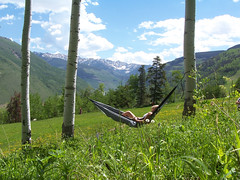[This blog post is part of Trek Light Gear’s Sleeping In A Hammock series. If you came here first, you should definitely read the introduction to this series and find out what this is all about and why we’re doing it. Click the link above or right here!]
To help you understand how to find the right hammock to sleep in (and why), I really need to begin by telling you what’s wrong with the hammocks that have led to so many bad hammock experiences over the years. If you live in the United States and had a hammock growing up or even had a neighbor with one in their backyard, chances are it looked a lot like the hammock in the picture to the right. Hammocks like this are not just found in the United States by any means, but I use the example because they have completely dominated the hammock market in the United States since their introduction. Characterized by the wooden spreader bars at each end and a knotted rope design with widely spaced holes much like a cargo net, this type of hammock can be found from backyards to beaches and in countless paintings, photos, movies and Corona commercials. This dominance of both commerce and culture has led them to become the accepted and definitive image of what a classic hammock looks like to most people (again I can only speak to my experience in the US, but I’m guessing the same applies to many countries).
As I mentioned in the introduction to this series, millions of people in Central and South America sleep in hammocks as their bed of choice every single night. Yet outside of those areas and especially in the US, hammocks are generally thought of as a comfortable but momentary respite. Like your favorite recliner, lots of people I’ve spoken with see hammocks as a great place to spend some time after a busy day and maybe even take a brief nap in, but not as something they’d be eager to spend the whole night in. Of course, since I started a business selling hammocks which I actively encourage people to sleep in, I’ve spent a lot of time trying to figure out what the reason is for this disparity. There are certainly cultural and geographic reasons, but I’m here to tell you unfortunate truth: you’ve been hammock brainwashed.
Thanks to the hammock image that has dominated our culture, what most people think of as the basic design of a hammock is actually vastly different from the hammocks that dominate Central and South America and have served as comfortable and healthy beds for
centuries (the hammock to the left is just one example of such a hammock). In fact, the two defining characteristics that you’re likely most familiar with, the wooden spreader bars and thick rope construction, aren’t even present at all and you’ll see why they’re also the reason that the hammock you know and love is actually the least practical and least comfortable when it comes to spending any more than a short period of time in the hammock. Once you realize how important these differences in design are, it will come as no surprise that there is such a huge disconnect in the way hammocks are perceived by people around the world and that the idea of sleeping in a hammock is generally met with so much skepticism in the United States.
Part I: The Leading Cause Of Hammock Fear (Or, Why Spreader Bars Are The Devil)
The hammock existed in its traditional forms for many centuries before the spreader bar was added to it, so what exactly are they for and why were they added? For starters, they function to keep the hammock spread open at all times and give it a flatter, more bed-like appearance than traditional hammocks without the bars. The history is a bit hard to trace, but it’s generally understood that it was intended to make the hammock more accessible to the masses by making it flatter and more bed-like in appearance

(or, if you believe this story it was actually introduced entirely by accident because "hammocks are hard to draw”). If the popularity of the spreader bar hammock and its prevalent imagery in our art and culture is any indication, it was an extremely successful design change! Actually though, this attempt to make the hammock look flatter and more bed-like for skeptical first time hammockers has to be one of the biggest illusions in product design history. Before the spreader bars were introduced the hammock didn't look anything like a flat bed on first glance, but once you got in you could stretch out, lay flat and most importantly, not worry about falling out. It was the introduction of these spreader bars that turned the hammock from a stable sleeping device into a roller coaster ride that can easily spin, flip, twist and turn until you either wind up face down on the ground or manage to situate yourself (and anyone else still along for the ride) into a careful balance of weight, angle and a little bit of luck. That’s right, hammocks aren’t supposed to flip over and dump you on the ground, we made them that way.
“I’ll fall flat on my face if I even try to get into that thing” – Too Many People
In 7+ years of talking to people about hammocks and asking many thousands of people if they’d like to lie down in one and try it out, I’ve observed a completely unexpected and unnecessary phenomenon: Hammock Fear. I kid you not. I meet more people some days who are afraid to get into a hammock than people who are thrilled to have a chance to kick their feet up and relax. Not just jokingly afraid, some of these people are scarred for life and turned off by hammocks because they’ve been dumped out hard on the ground in the past (usually in front of other people which doesn’t seem to help). To those of you living with Hammock Fear, let me repeat what I said above:
Hammocks Are Not Supposed To Flip!!!
Regardless of whether you love hammocks or fear hammocks, this is a crucial point when it comes to sleeping in a hammock. If you have to worry about falling out of your hammock in the middle of the night or in the middle of your nap, you’re in the wrong hammock. You don’t stay still when you sleep in your bed and you’re bound to move around at times when sleeping in a hammock (although you’ll actually toss and turn much less thanks to a hammock’s lack of pressure points which typically cause you to shift around when you sleep on a bed or flat surface). The last thing you should have to worry about when trying to get a peaceful and healthy rest in your hammock is that you’ll move a little to the side and suddenly find yourself having a quick meeting with the ground.
If I were to go out Family Feud style and survey 100 people for the words that come to mind when they think of a hammock, I guarantee you spinning, flipping or falling out of them would easily make the top 10. As you now know, those words shouldn’t even be associated with a hammock, but this hammock brainwashing has been going on for a very long time. Keep in mind this isn’t just a hunch, it’s a conversation I’ve had with thousands of people over the years at various trade shows, music festivals and at our kiosk in Boulder. I’ve seen so many people absolutely blown away when I show them that Trek Light Gear’s hammocks don’t spin or flip. They’re so convinced that ALL hammocks flip, you’d think I just showed them how to get drunk without a hangover. I even describe it in our marketing now as Trek Light Gear’s No-Flip™ design, because it was obvious that most customers identified it as an added feature rather than a given. Of course, the inherent danger and instability is not a necessary evil required to enjoy a hammock and yet the hammock brainwashing is so strong that what’s perceived by most as a revolutionary new feature is really something that millions of people have been enjoying in their hammocks for centuries. (To be fair/proud, there are lots of aspects to the Trek Light design that make it even sturdier and more durable than traditional woven hammocks, but if you’re in just about any non-spreader bar hammock you should have a much more ‘balanced’ experience).
For the casual hammock user, the benefits of having a hammock that doesn’t spin or flip are easily enjoyed even if you only spend brief periods of time in your hammock and never fall asleep. Besides being a much safer experience, when you climb into a hammock that doesn’t spin or flip you can immediately relax in a way that you can’t do if you’re worried about staying balanced or centered. It’s a lot like trying to get a massage or meditate while you’re still tensed up, you’re never going to get the most out of the experience if you aren’t able to completely let go and relax your body.
I’ll be the first to admit that the spinning and flipping was easily my favorite thing about a hammock as a kid and I’ll happily concede my ‘spreader bars are the devil’ point if that’s what you’re looking for in your hammock experience. I’m also well aware that if you know what you’re doing you should be able to use a spreader bar hammock without falling and without necessarily having a bad experience. But, you’re reading this because you want to know the healthiest, safest and most comfortable way to sleep in a hammock. If you want to get a good night sleep in a hammock and if you want to enter a state of complete relaxation without distraction, you need to break free of the hammock brainwashing, lose your nostalgia for the hammocks you grew up with and purchase one without a spreader bar (and make sure it’s designed to minimize or prevent flipping over).
Actually, the more I look at funny videos of people falling out of hammocks (very important research for this article) the more I’m beginning to think the spreader bar is not so much a design flaw but a practical joke passed down from generation to generation. I mean, just look at that priceless picture above. I only wish we could call the unstable spreader bar hammocks by another name so it wouldn’t lead to so many cases of unnecessary Hammock Fear and Hammock Brainwashing. Hammock Comedy, though, that’s something I can get behind…
I want to hear from you in the comments! Share your stories of good or bad hammock experiences, step up to defend the spreader bar or just let me know what you think about this guide so far. Better yet, if you have any good pictures (or videos) of someone falling out of an unsafe hammock, send them in and we’ll include them in the post!
There’s lots more to come, next up we’ll explore more of How You’ve Been Hammock Brainwashed with Part II: The Human Waffle Effect. Thanks for reading and stay tuned!





